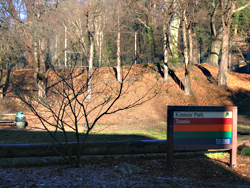Nothing gets Seattleites more riled up than a dog run (or “off-leash area,” to use the preferred term). Hundreds of citizens can be depended upon to attend Parks Department and City Council hearings on the subject. Reaching consensus on location, design, hours, and the like is as difficult as retrieving your dog’s tennis ball from a Jack Russell terrier. Yet process finally gave way to a decision for Kinnear Park, which extends down the southwest shoulder of Queen Anne Hill to Elliott Avenue West. A new dog run, the 12th in the city, was approved by the Seattle Parks Department last fall. But there are a couple problems: One, there’s no money for it. Two, the area just below where the dog run is supposed to be situated is currently occupied by regular encampments of the homeless.
While the upper portion of 118-year-old, Olmsted-designed Kinnear Park, across from the apartment buildings of West Olympic Place, is relatively clean and well maintained, with a view outlook and swings and sandboxes for the kids, lower Kinnear is quite different. From the dead end of West Roy Street, a muddy greenbelt trail leads down to a dark 5-acre expanse strewn with 40-ounce cans, sleeping dens lined with cardboard, and the detritus of many unofficial residents. (Two dusty tennis courts count as lower Kinnear’s only amenities.) Summertime is especially lively, with transient men often gathered to drink around campfires.
“Everyone in Queen Anne knows that lower Kinnear Park is just a place you don’t go because it’s not safe,” says Michael Jerrett, executive director of the Fremont Chamber of Commerce and president of the Uptown Alliance community group. Beating deaths were reported in 1999 and 2003; the Seattle Police Department didn’t return several calls seeking other crime statistics.
Kinnear Park wasn’t included in 2000’s $198 million Pro Parks Levy, which acquired new plots and spruced up old parks all over the city. It’s essentially been allowed to languish and serve as a de facto campground. “We try to be as laissez-faire as we can,” says Parks Department spokesperson Dewey Potter. “Because life is tough with these folks. We try to look the other way.”
Uptown, on the other hand, is a fast-gentrifying area looking to receive more residents, more density, and increased real-estate values. Now that the threat of monorail blight has been removed, the LQA hood is benefiting from Belltown overflow—for buyers, cheaper condos and three proximate grocery stores; and for developers, many more fallow parking lots and tear-down apartment buildings (some originally constructed as motels for the 1962 World’s Fair).
The park has long been a magnet for transients. Thirty to 50 years ago, lower Kinnear Park basically fronted a rail yard, says the Uptown Alliance’s John Gessner, who’s lived in the area for some three decades. “The hobos would come on the trains from Eastern Washington and pick apples,” he recalls.
“It’s a beautiful hiding place,” according to Michael Paddy, director of CityTeam Ministries, an Elliott Avenue men’s shelter and rehab facility that sits at the foot of the park. The homeless are “covered with tarps and tents. They feel comfortable and safe. If you go to any other park, [officials will] kick you out.”
There are periodic Kinnear cleanups organized by the Parks Department, with volunteers from the community, CityTeam, and the Church of Scientology (which is building a new headquarters just blocks away). The debris is almost like hazmat waste, Gessner says: “You need the guys with the masks and suits.”
Gessner and other nearby residents complain that Paddy’s ministry is part of what attracts street people to the park. “They do open feeding,” Gessner claims, meaning they offer free meals to anyone, no matter whether drunk or resisting treatment. Paddy disputes that. “You can’t come in for a meal without blowing into a straw,” he says, noting that every visitor is required to take a breathalyzer test or meet the house standard of not being “overly high or drunk or [exhibiting] a posture of violent behavior.”
“We don’t bring the homeless at all,” Paddy says. “If we weren’t there, it would increase.”
California-based CityTeam came to Seattle in 1998 and merged with the old Peniel Mission at First Avenue and Wall Street (now occupied by the Ace Hotel and Cyclops restaurant). Belltown was already well served with shelters, so CityTeam headed toward Kinnear Park, where, Paddy estimates, up to 100 people occupied the greenbelt. He and his two paid staff members try to talk campers down into their no-drugs, no-drink facility (which has a maximum capacity of about 100 beds) and have permanently coaxed down 20, he says. “There are only around 30 up there [now] because of the weather.”
As for those who misbehave, “We do not allow any of our guys to use our back door if they’re drunk and disorderly to go into Kinnear Park,” Paddy says. Instead, they’re gently booted onto Elliott. As for where they go next, he concedes, “We’re not the police.”
Meanwhile, another meeting is planned for Monday where, as the city Web site puts it, “Parks would like to hear from park neighbors about what activities they would enjoy in the park.” (Badminton perhaps? Croquet, anyone?) Later will come endless planning, process, and probable solicitation of matching funds. (Counterbalance Park, near the commercial heart of Lower Queen Anne, is scheduled to break ground this summer with $300,000 from the Pro Parks Levy and even more from private sources.) Lower Kinnear won’t gentrify overnight. However, its tent dwellers will likely find themselves chased out—if not by the dogs, then by those on the other end of the leash.








